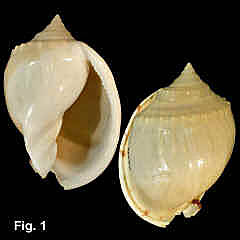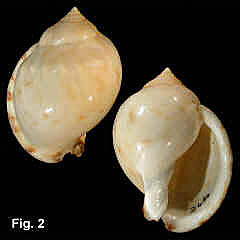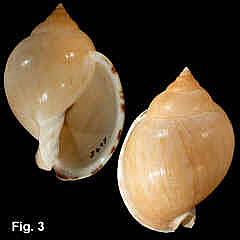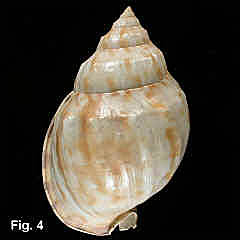|
|
|
||||||||

|
Semicassis pryum (Lamarck, 1822) Description: Extremely variable in colour, shape and size. Shells vary from smooth and round shouldered (figure 3), to sharply angled and nodulose at the shoulder with spiral grooves and ridges between shoulder and suture. Nodulose shells usually have one row of nodules at the shoulder, occasionally a second row below the shoulder (figures 1 and 2). Base of body whorl usually spirally grooved, faintly in some shells. Outer lip reflected, usually smooth, occasionally toothed posteriorly. Columella shield with central spiral ridge of varying strength and sometimes lirae anteriorly; outer margin straight. Umbilicus open. Colour uniform light brown or fawn, sometimes with four spiral rows of brown blotches or axial streaks. Size: Adult shells 30-151 mm high. Distribution: Port Stephens, NSW, to Eucla, WA. Also New Zealand and South Africa. Habitat: Taken in 50-650 m. Common. Remarks: Forms of this species have been assigned specific names including Cassis nivea Brazier, 1872, Cassidea stadialis Hedley, 1914, Xenogalea spectabilis Iredale, 1929 and Xenophalium hedleyi Iredale, 1927, but Abbott (1968) has shown there is continual variation between the forms. Abbott recognized the following forms in the Australian population, but noted there is continuous variation between the forms:: form niveum (Fig 1). Sharply angled shoulder with two rows of nodules. Size typically 50-90 mm. Occurs throughout the range. form spectabile (Fig 2). Weakly nodulose shoulder. This is intermediate between the smooth stadiale form and the nodulose niveum form. Occurs throughout the range. form stadiale (Fig. 3). Rounded shoulders with no nodules, with size typically 70-90 mm. It occurs throughout the range, but is the most common form in NSW. form hedleyi (Fig 4). This is a rare, large (150 mm), nodulose, lightweight form which occurs only in NSW. It was described as a distinct species Xenophalium hedleyi Iredale, 1927. Since Abbott's work specimens from deeper water off the central NSW coast have become commonly available. These shells, taken down to 650 metres,are of the stadiale form but are uniformly fawn in colour, and unpolished. The spiral grooves, which are restricted to the base of the body whorl in shallow water shells, may extend to cover the entire shell in these deep water specimens. Fig. 1: Great Australian Bight, 146-220 m (C.035588) Fig. 2: From fishermen at Eden, NSW (DLB2484) Fig. 3: Off Sydney, in 420-440 m (DLB2493) Fig. 4: HOLOTYPE of Xenophalium hedleyi. 5 miles off Kiama, NSW, in 70 fathoms (C.053265)
|
||||||||
|
Copyright Des Beechey 2000 |


